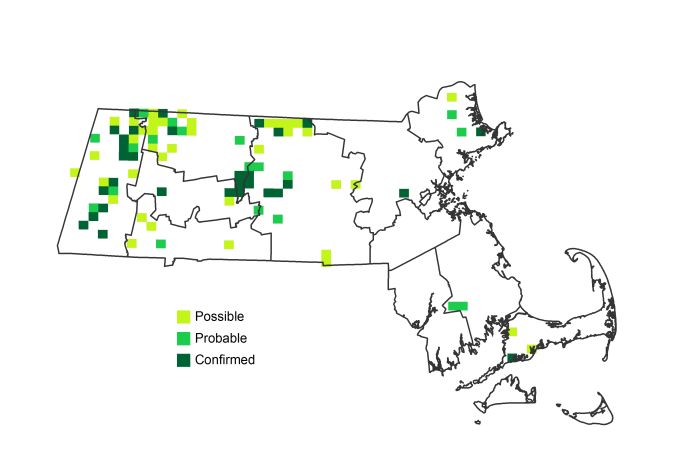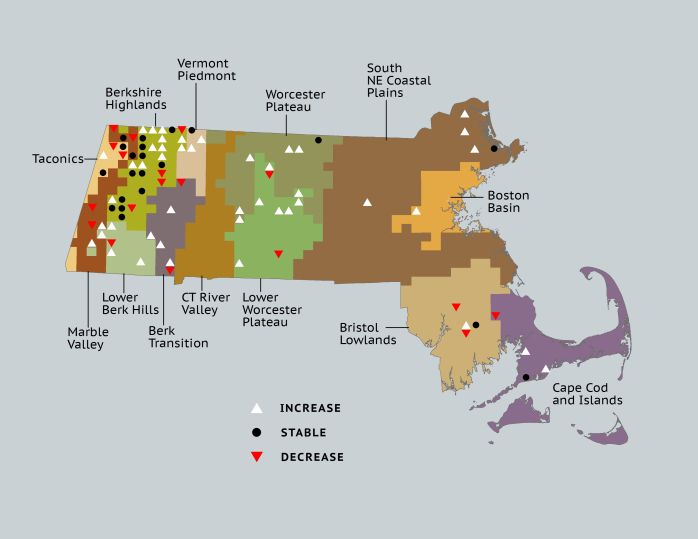Find a Bird
Golden-crowned Kinglet
Regulus satrapa

Local and likely increasing

“Many years ago, a boy found on the doorstep the body of a tiny feathered gem…. He picked it up and was entranced with the delicate beauty of its soft olive colors and with its crown of brilliant orange and gold, which glowed like a ball of fire.” – Arthur Cleveland Bent, Life Histories of North American Birds
The fiery crown of the Golden-crowned Kinglet is easily its most memorable plumage feature. Unfortunately, these birds are most often only glimpsed from below, when they are seen at all. Golden-crowned Kinglets are birds of the northern conifer forest, where they can occasionally be spotted flitting through the canopy in pursuit of insects. They are more commonly encountered as fall migrants than as breeding birds in Massachusetts, but recovering or artificially created forests are allowing them to expand their breeding range somewhat.
Historic Status
Early observers of Massachusetts birdlife believed that “Fiery-crowned Wrens,” later known as Golden-crowned Kinglets, bred solely in Labrador (Little & Brown 1841), but, by the latter half of the nineteenth century, they were suspected of breeding in western Massachusetts. Joel Asaph Allen surmised in the 1870s that the fact that they had bred in the Catskills made them a potential breeder in the Berkshires as well (Allen 1878). By 1900, his suspicions were verified, but by the late 1920s things took a turn for the worse. “Old residents say that it has disappeared since the spruce and pine were cut from a large part of the region in western Massachusetts where it formerly bred,” wrote Edward Howe Forbush (Forbush 1929). It never fully vanished, though, and the species was even found breeding in the southeastern portion of the state on occasion.
Atlas 1 Distribution
Eastern excursions aside, breeding Golden-crowned Kinglets were largely concentrated in the western highlands of the state in Atlas 1. The Taconic Mountains, the higher ridges of the Marble Valleys, and most especially the Berkshire Highlands all appealed to kinglets. Moving east, Golden-crowned Kinglet distribution was much more scattered, with only a few individual records peppering the landscape. Some of these were at the northern edges of the state, such as one in the Worcester Plateau, but many others were in stands of deliberately planted spruce trees (Petersen & Meservey 2003). Such was the case with many of the eastern records in the Bristol/Narragansett Lowlands and the Cape and Islands, where introduced Norway Spruce plantations created new nesting opportunities for Golden-crowned Kinglets (Petersen & Meservey 2003).
Atlas 2 Distribution and Change
Slow and steady growth best describes the distribution of this species in Massachusetts. Theirs has been a story of spreading into contiguous blocks in occupied regions, rather than making huge leaps across the state. Atlas 2 found Golden-crowned Kinglets well distributed through the highest regions of the western and central parts of the state, and increasing only incrementally at the lower elevations. About 60% of their statewide occupied blocks were in the Berkshire Highlands and Worcester and Lower Worcester Plateau ecoregions, clearly reflecting the importance of elevation for this species. Although they were increasing in block occupancy in most western regions, the Berkshire Highlands, Lower Berkshire Hills, Vermont Piedmont, and Worcester Plateau reflected the highest net gains in blocks during the inter-Atlas period.
Atlas 1 Map

Atlas 2 Map

Atlas Change Map

Ecoregion Data
Atlas 1 | Atlas 2 | Change | ||||||
Ecoregion | # Blocks | % Blocks | % of Range | # Blocks | % Blocks | % of Range | Change in # Blocks | Change in % Blocks |
Taconic Mountains | 4 | 25.0 | 10.3 | 4 | 16.0 | 4.5 | -1 | -6.7 |
Marble Valleys/Housatonic Valley | 6 | 15.4 | 15.4 | 4 | 10.3 | 4.5 | -2 | -5.1 |
Berkshire Highlands | 16 | 29.1 | 41.0 | 26 | 47.3 | 29.5 | 8 | 15.1 |
Lower Berkshire Hills | 1 | 3.6 | 2.6 | 4 | 12.9 | 4.5 | 3 | 11.1 |
Vermont Piedmont | 1 | 5.9 | 2.6 | 5 | 29.4 | 5.7 | 2 | 16.7 |
Berkshire Transition | 2 | 5.3 | 5.1 | 4 | 10.0 | 4.5 | 2 | 6.5 |
Connecticut River Valley | 0 | 0.0 | 0.0 | 0 | 0.0 | 0.0 | 0 | 0.0 |
Worcester Plateau | 1 | 1.3 | 2.6 | 15 | 17.0 | 17.0 | 5 | 10.4 |
Lower Worcester Plateau | 2 | 2.7 | 5.1 | 12 | 15.0 | 13.6 | 5 | 9.3 |
S. New England Coastal Plains and Hills | 1 | 0.4 | 2.6 | 8 | 2.8 | 9.1 | 4 | 1.8 |
Boston Basin | 0 | 0.0 | 0.0 | 1 | 1.8 | 1.1 | 1 | 1.8 |
Bristol and Narragansett Lowlands | 3 | 2.8 | 7.7 | 2 | 1.8 | 2.3 | -1 | -1.0 |
Cape Cod and Islands | 2 | 1.5 | 5.1 | 3 | 2.1 | 3.4 | 1 | 0.8 |
Statewide Total | 39 | 4.0 | 100.0 | 88 | 8.5 | 100.0 | 27 | 3.3 |



